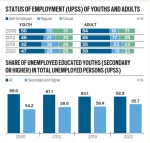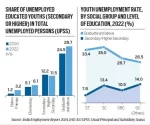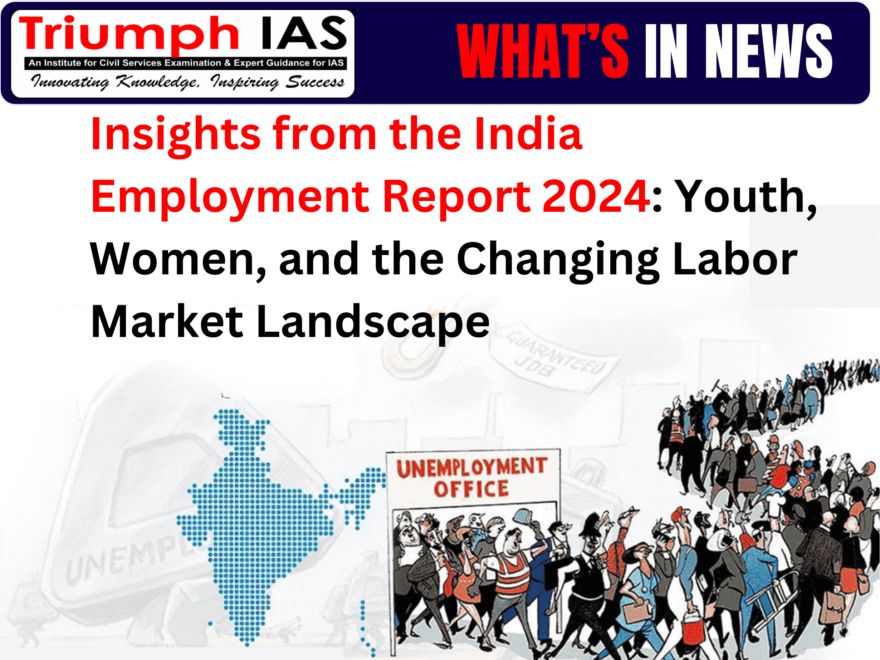Insights from the India Employment Report 2024: Youth, Women, and the Changing Labor Market Landscape
| For Prelims : International Labour Organisation’s (ILO), Unemployment, Labor Market, For Mains : Insights from the India Employment Report 2024 |
Why in News
The latest India Employment Report 2024, jointly released by the Institute for Human Development and the International Labour Organization, highlights significant improvements in labor market indicators despite periods of economic downturn, both preceding and during the Covid-19 pandemic.
In recent years, there have been unexpected enhancements in key labor market metrics such as the labor force participation rate, workforce participation rate, and unemployment rate in India. This comes after a prolonged period of decline from 2000 to 2019. The report underscores concerns regarding unfavorable employment conditions, including a reversal in the slow shift towards non-farm employment, a notable increase in self-employment and unpaid family work, and lower-quality employment opportunities for youth compared to adults. Additionally, it notes stagnant or decreasing wages and earnings.
 The report introduces the ’employment condition index,‘
The report introduces the ’employment condition index,‘
which has shown improvement between 2004-05 and 2021-22. However, some states, such as Bihar, Odisha, Jharkhand, and UP, have consistently ranked poorly in this index, while others like Delhi, Himachal Pradesh, Telangana, Uttarakhand, and Gujarat have consistently performed well.
This index is based on seven labor market outcome indicators, including the percentage of workers in regular formal work, casual laborers, self-employed workers below the poverty line, work participation rate, average monthly earnings of casual laborers, unemployment rate among secondary and above-educated youth, and youth not engaged in employment, education, or training.
Employment Quality
Regarding employment quality, the report highlights a rise in informal employment, with approximately half of the formal sector jobs being informal. Self-employment and unpaid family work, particularly among women, have also increased. The majority of the workforce, around 82%, is engaged in the informal sector, with nearly 90% being informally employed.
 Self-employment
Self-employment
Self-employment remains the primary source of employment, accounting for 55.8% in 2022. Casual and regular employment constitute 22.7% and 21.5%, respectively. While the share of self-employment remained relatively stable at around 52% between 2000 and 2019, there was a significant increase in regular employment during this period. However, this trend reversed by 2022, with self-employment rising to 55.8%, and the share of regular employment declining to 21.5%. Casual employment consistently decreased from 33.3% in 2000 to 22.7% in 2022.
This shift was mainly absorbed by the construction and services sectors, whose share of total employment increased from 23% in 2000 to 32% in 2019. In contrast, the share of manufacturing in employment has remained almost unchanged at 12-14%.
However, since 2018-19, this slow transition has either stalled or reversed with the increase in the share of agricultural employment.
Regarding youth employment, there has been an uptick, but concerns persist over the quality of work, particularly for educated young workers.
Youth Employment
While youth employment and underemployment rose between 2000 and 2019, they declined during the pandemic years. Nevertheless, unemployment among youths, especially those with secondary-level or higher education, has worsened over time.
In 2022, the proportion of unemployed youths in the total unemployed population stood at 82.9%. The share of educated youths among all unemployed individuals also rose to 65.7% in 2022 from 54.2% in 2000.
The unemployment rate among educated youths was six times higher for those with secondary education or higher (18.4%) and nine times higher for graduates (29.1%) compared to those who were illiterate (3.4%) in 2022. This discrepancy was more pronounced among educated young women (21.4%) than men (17.5%), particularly among female graduates (34.5%) compared to male graduates (26.4%).
While the unemployment rate among educated youths increased from 23.9% in 2000 to 30.8% in 2019, it dropped to 18.4% in 2022.
Moving forward,
There are five key policy areas for further action:
- Promoting job creation
- Enhancing employment quality
- Addressing labor market inequalities
- Strengthening skills and active labor market policies
- And filling knowledge gaps on labor market patterns and youth employment.
The report also notes the potential impact of artificial intelligence (AI) on employment, highlighting potential disruptions in the outsourcing industry due to AI taking over certain back-office tasks.
Investments and regulations are needed in emerging sectors like care and digital economies, which could provide significant sources of productive employment. Challenges such as job insecurity, irregular wages, and uncertain employment status in gig or platform work need to be addressed.
Economic policies should focus on boosting productive non-farm employment, particularly in the manufacturing sector, as India is expected to add 7-8 million youths annually to the labor force over the next decade. Additionally, more support should be provided to micro, small, and medium-sized enterprises, including tools such as digitalization and AI, along with a cluster-based approach to manufacturing.
Sources: The Indian Express
What is the International Labour Organisation?
|
Question asked in UPSC
|
GS Related Practices Question…
To master these intricacies and fare well in the Sociology Optional Syllabus, aspiring sociologists might benefit from guidance by the Best Sociology Optional Teacher and participation in the Best Sociology Optional Coaching. These avenues provide comprehensive assistance, ensuring a solid understanding of sociology’s diverse methodologies and techniques.
META TAGS:
Current affairs , Today news, Today news GS, Today news UPSC , Today news and views, Today news 2024, Today news Current affairs March 2024, Current affairs news, Current affairs book pdf, Current affairs best blog, Current affairs for UPSC, Current affairs 2024, Current affairs contact, Current affairs book, Current affairs program meaning

Choose The Best Sociology Optional Teacher for IAS Preparation?
At the beginning of the journey for Civil Services Examination preparation, many students face a pivotal decision – selecting their optional subject. Questions such as “which optional subject is the best?” and “which optional subject is the most scoring?” frequently come to mind. Choosing the right optional subject, like choosing the best sociology optional teacher, is a subjective yet vital step that requires a thoughtful decision based on facts. A misstep in this crucial decision can indeed prove disastrous.
Ever since the exam pattern was revamped in 2013, the UPSC has eliminated the need for a second optional subject. Now, candidates have to choose only one optional subject for the UPSC Mains, which has two papers of 250 marks each. One of the compelling choices for many has been the sociology optional. However, it’s strongly advised to decide on your optional subject for mains well ahead of time to get sufficient time to complete the syllabus. After all, most students score similarly in General Studies Papers; it’s the score in the optional subject & essay that contributes significantly to the final selection.
“A sound strategy does not rely solely on the popular
Opinion of toppers or famous YouTubers cum teachers.”
It requires understanding one’s ability, interest, and the relevance of the subject, not just for the exam but also for life in general. Hence, when selecting the best sociology teacher, one must consider the usefulness of sociology optional coaching in General Studies, Essay, and Personality Test.
The choice of the optional subject should be based on objective criteria, such as the nature, scope, and size of the syllabus, uniformity and stability in the question pattern, relevance of the syllabic content in daily life in society, and the availability of study material and guidance. For example, choosing the best sociology optional coaching can ensure access to top-quality study materials and experienced teachers. Always remember, the approach of the UPSC optional subject differs from your academic studies of subjects. Therefore, before settling for sociology optional, you need to analyze the syllabus, previous years’ pattern, subject requirements (be it ideal, visionary, numerical, conceptual theoretical), and your comfort level with the subject.
This decision marks a critical point in your UPSC – CSE journey, potentially determining your success in a career in IAS/Civil Services. Therefore, it’s crucial to choose wisely, whether it’s the optional subject or the best sociology optional teacher. Always base your decision on accurate facts, and never let your emotional biases guide your choices. After all, the search for the best sociology optional coaching is about finding the perfect fit for your unique academic needs and aspirations.
To master these intricacies and fare well in the Sociology Optional Syllabus, aspiring sociologists might benefit from guidance by the Best Sociology Optional Teacher and participation in the Best Sociology Optional Coaching. These avenues provide comprehensive assistance, ensuring a solid understanding of sociology’s diverse methodologies and techniques. Sociology, Social theory, Best Sociology Optional Teacher, Best Sociology Optional Coaching, Sociology Optional Syllabus.
Best Sociology Optional Teacher, Sociology Syllabus, Sociology Optional, Sociology Optional Coaching, Best Sociology Optional Coaching, Best Sociology Teacher, Sociology Course, Sociology Teacher, Sociology Foundation, Sociology Foundation Course, Sociology Optional UPSC, Sociology for IAS,
Follow us :
🔎 https://www.instagram.com/triumphias
🔎https://www.youtube.com/c/TriumphIAS
🔎https://t.me/VikashRanjanSociology
Find More Blogs…
| Compare and contrast Karl Marx’s and Max weber’s | Karl Marx- Historical Materialism |
| Talcott Parsons : Social system | Scope of the subject and comparison with other social sciences |
Key Words: Insights from the India Employment Report 2024 , Insights from the India Employment Report 2024 , Insights from the India Employment Report 2024 , Insights from the India Employment Report 2024 , Insights from the India Employment Report 2024 , Insights from the India Employment Report 2024 , Insights from the India Employment Report 2024 , Insights from the India Employment Report 2024 , Insights from the India Employment Report 2024 , Insights from the India Employment Report 2024 , Insights from the India Employment Report 2024 , Insights from the India Employment Report 2024 , Insights from the India Employment Report 2024 , Insights from the India Employment Report 2024 , Insights from the India Employment Report 2024 , Insights from the India Employment Report 2024 ,




